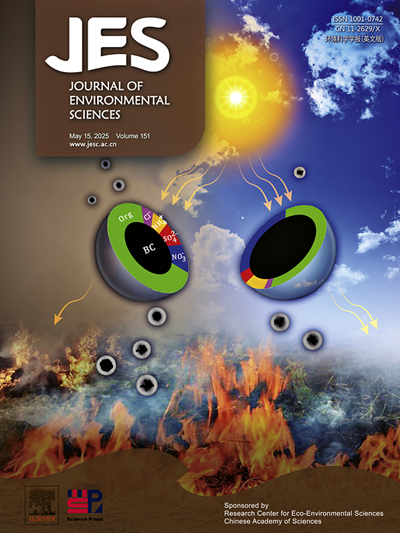泉水径流对水处理过程中2,6-二氯-1,4-苯醌生成的影响
IF 6.3
2区 环境科学与生态学
Q1 ENVIRONMENTAL SCIENCES
引用次数: 0
摘要
研究了水源水源径流对卤苯醌(halobenzoquinones, HBQs)形成的影响及其与常见水质参数(WQPs)和芳香氨基酸(aromatic amino acids, AAs)的相关性。分别于2021年、2022年和2023年在两个饮用水处理厂收集了水源水和处理后的水样。采用固相萃取高效液相色谱-串联质谱法分析hbq和芳香原子吸收物。处理水中检测到的hbq仅为2,6-二氯-1,4-苯醌(DCBQ)和羟基-DCBQ (OH-DCBQ)。春径流期DCBQ浓度比非春径流期高3 ~ 4倍,表明春径流对DCBQ的形成有影响。成品水DCBQ浓度与2021年和2022年水源水颜色、溶解有机碳、总有机氮和比紫外吸光度WQPs呈正相关。源水中总芳香原子吸收量的变化趋势与成品水中DCBQ呈显著正相关。最后,在添加氯后立即测定的DCBQ浓度与其转化产物OH-DCBQ在成品水中的存在之间存在显著的正相关关系。粉状活性炭可以去除源水中部分HBQ前体,减少DCBQ的形成。本研究表明,在饮用水处理过程中,WQPs和芳香AAs是去除前体以减少HBQ形成的有用指标。本文章由计算机程序翻译,如有差异,请以英文原文为准。
Effect of spring runoff on 2,6-dichloro-1,4-benzoquinone formation during water treatment
This study investigated the impacts of spring runoff on the formation of halobenzoquinones (HBQs) and their correlation with common water quality parameters (WQPs) and aromatic amino acids (AAs) in source water. Source water and treated water samples were collected at two drinking water treatment plants in 2021, 2022, and 2023. HBQs and aromatic AAs were analyzed using solid phase extraction with high performance liquid chromatography–tandem mass spectrometry methods. The only HBQs detected in treated water were 2,6-dichloro-1,4-benzoquinone (DCBQ) and hydroxy‑DCBQ (OH-DCBQ). The concentration of DCBQ was 3–4 times higher during spring runoff events than during non-spring-runoff periods, suggesting the impact of spring runoff on the formation of DCBQ. The DCBQ concentrations in finished water positively correlated with the color, dissolved organic carbon, total organic nitrogen, and specific ultraviolet absorbance WQPs of source water in 2021 and 2022. The temporal trend of the total aromatic AAs determined in source water was strongly and positively correlated to DCBQ in finished water. Finally, there was a significant positive correlation between the concentration of DCBQ determined immediately following the addition of chlorine and the presence of its transformation product, OH-DCBQ, in finished water. The results also showed that powdered activated carbon can remove some of the HBQ precursors in the source water to reduce DCBQ formation. This study demonstrated that WQPs and aromatic AAs are useful indicators for the removal of precursors to reduce HBQ formation during drinking water treatment.
求助全文
通过发布文献求助,成功后即可免费获取论文全文。
去求助
来源期刊

Journal of Environmental Sciences-china
环境科学-环境科学
CiteScore
13.70
自引率
0.00%
发文量
6354
审稿时长
2.6 months
期刊介绍:
The Journal of Environmental Sciences is an international journal started in 1989. The journal is devoted to publish original, peer-reviewed research papers on main aspects of environmental sciences, such as environmental chemistry, environmental biology, ecology, geosciences and environmental physics. Appropriate subjects include basic and applied research on atmospheric, terrestrial and aquatic environments, pollution control and abatement technology, conservation of natural resources, environmental health and toxicology. Announcements of international environmental science meetings and other recent information are also included.
 求助内容:
求助内容: 应助结果提醒方式:
应助结果提醒方式:


